中国药科大学药剂学 Controlled Sustained-Release Drug Delivery Systems知识课件
药剂学知识总结——中国药科大学09级生命基地

名词解释药剂学pharmaceutics是研究药物制剂的基本理论、生产技术、质量控制和临床合理使用的综合学科。
制剂学pharmaceutical engineering研究制剂的理论和制备工艺的科学和调剂学dispensing pharmaceutics。
制剂pharmaceutical preparation以剂型体现的药物的具体品种,能直接用于患者,如阿司匹林片剂、氯霉素注射剂、氯霉素眼药水等。
剂型dosage forms把药物制备成适合某种给药形式的给药形式及类别,即一类药物制剂的总称,如片剂、胶囊剂、注射剂、软膏剂、糖浆剂、气雾剂、栓剂等。
药典pharmacopoeia一个国家记载药品规格、标准的法典,一般由国家药典委员会组织编撰、出版,并由政府颁布、执行,具有法律约束力。
Good Manufacturing Practice, GMP药品质量生产质量管理规范,是药品生产过程中,用科学、合理、规范化的条件和方法来保证生产优良药品的一整套系统的、科学的管理规范,是药品生产和管理的基本准则。
Good Laboratory Practice, GLP药物非临床研究质量管理规范,是研究室实验研究,从计划、实验、监督、记录到实验报告等一系列管理而制定的法规性文件,涉及到实验室工作的所有方面。
Good Clinical Practice, GCP药物临床试验管理规范,是规范药品临床试验全过程的标准规定,包括方案设计,组织实施,监察,稽查,记录,分析总结和报告。
处方药prescription drug必须凭执业药师或执业助理医师的处方才可调配、购买,并在医生指导下使用的药品。
非处方药nonprescription drug/ over the counter, OTC不需要执业医师或执业助理医师的处方,消费者可以自行判断购买和使用的药品,安全性要求较高。
药物传递系统Drug Delivery System, DDS以适宜的剂型和给药方式,用最小的剂量达到最好的治疗效果。
中国药科大学药剂学重点考前整理
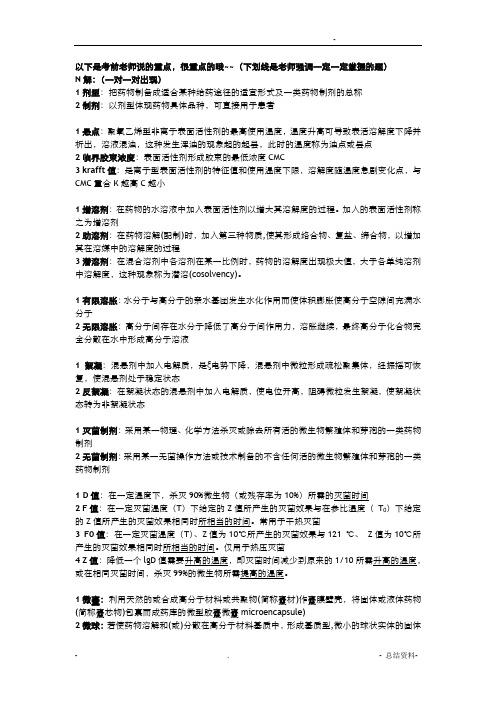
以下是考前老师说的重点,很重点的哦~~(下划线是老师强调一定一定掌握的题)N解:(一对一对出现)1剂型:把药物制备成适合某种给药途径的适宜形式及一类药物制剂的总称2制剂:以剂型体现药物具体品种,可直接用于患者1悬点:聚氧乙烯型非离子表面活性剂的最高使用温度,温度升高可导致表活溶解度下降并析出,溶液混浊,这种发生浑浊的现象起的起昙,此时的温度称为浊点或昙点2临界胶束浓度:表面活性剂形成胶束的最低浓度CMC3 krafft值:是离子型表面活性剂的特征值和使用温度下限,溶解度随温度急剧变化点,与CMC重合K越高C越小1增溶剂:在药物的水溶液中加入表面活性剂以增大其溶解度的过程。
加入的表面活性剂称之为增溶剂2助溶剂:在药物溶解(配制)时,加入第三种物质,使其形成络合物、复盐、缔合物,以增加其在溶媒中的溶解度的过程3潜溶剂:在混合溶剂中各溶剂在某一比例时,药物的溶解度出现极大值,大于各单纯溶剂中溶解度,这种现象称为潜溶(cosolvency)。
1有限溶胀:水分子与高分子的亲水基团发生水化作用而使体积膨胀使高分子空隙间充满水分子2无限溶胀:高分子间存在水分子降低了高分子间作用力,溶胀继续,最终高分子化合物完全分散在水中形成高分子溶液1絮凝:混悬剂中加入电解质,是ξ电势下降,混悬剂中微粒形成疏松聚集体,经振摇可恢复,使混悬剂处于稳定状态2反絮凝:在絮凝状态的混悬剂中加入电解质,使电位开高,阻碍微粒发生絮凝,使絮凝状态转为非絮凝状态1灭菌制剂:采用某一物理、化学方法杀灭或除去所有活的微生物繁殖体和芽孢的一类药物制剂2无菌制剂:采用某一无菌操作方法或技术制备的不含任何活的微生物繁殖体和芽孢的一类药物制剂1 D值:在一定温度下,杀灭90%微生物(或残存率为10%)所需的灭菌时间2 F值:在一定灭菌温度(T)下给定的Z值所产生的灭菌效果与在参比温度(T0)下给定的Z值所产生的灭菌效果相同时所相当的时间。
常用于干热灭菌3 F0值:在一定灭菌温度(T)、Z值为10℃所产生的灭菌效果与121 ℃、Z值为10℃所产生的灭菌效果相同时所相当的时间。
药剂学-缓释、控释制剂、迟释制剂

2010年版中国药典收载的缓控释制剂
己酮可可碱缓释片
双嘧达莫缓释胶囊
单硝酸异山梨酯缓释片
布洛芬缓释胶囊
茶碱缓释片
盐酸曲马多缓释胶囊
氢溴酸右美沙芬缓释片
盐酸氨溴索缓释胶囊
盐酸曲马多缓释片
硝酸异山梨酯缓释胶囊
盐酸吗啡缓释片
硫酸沙丁胺醇缓释胶囊
盐酸维拉帕米缓释片
氨茶碱缓释片
雌二醇缓释贴片
酒石酸美托洛尔缓释片
13
(三)溶蚀与扩散、溶出结合
骨架片
释放药物
水
水
溶胀
释放药物 溶蚀
水
水
进一步溶蚀
完全溶解
释药机理研究 14
(四)渗透压原理
口服渗透泵片的构造:
(激光打孔)
(水溶性药物和水溶性聚合物或其他辅料)
(水不溶性聚合物,如 CA、EC)
释药原理:当与水接触后,水即通过半渗透膜进入片芯,
使药物溶解成为饱和溶液,由于渗透压的差 别,药物由细孔持续流出,其量与渗透进来的 水量相等,直至片芯内的药物溶解殆尽为止。
15
渗透压原理
以dm/dt 表示药物通过细孔释放速率,Cs为膜内药物饱和溶 液浓度,则
dm dt
CS
dV dt
K CS
16
两种类型渗透泵系统示意图
制备渗透泵片的关键因素
片芯的处方组成 包衣膜的通透性 包衣膜的厚度 释药孔的大小
17
渗透泵型 Osmosis-Pump Controlled-Release
19
聚苯乙烯型阴离子交换树脂
R-N(CH3)+Cl- +Drug-←→R-N(CH3)+Drug- +Cl-或 R-N(CH3)+OH- +Drug-←→R-N(CH3)+Drug- +OH-
对口服药物缓释及控释制剂

为胃内滞留药物的载体、采用pH敏感材料、电解质敏 感材料、肠道酶降解材料、定量溶胀、崩解材料等达 到结肠释药或脉冲释放等。
一定相同,因此不能预期剂型或释机理不同的某药物 的缓释控释制剂有相同的释放速度。
释放度应建立在对人体胃肠条件特征参数及对药物的 特征参数有较充分实验基础上才会有实际价值。进行 充分的药动学和药效学关系实验研究,建立合理的体 内外相关关系是全新的缓释控释制剂的开发工作中的 重要组成部分。 各时间释放度的上下限可能会给临床治疗有效性和安 全性带来不容忽视的影响。 很窄的释放度范围在生产 上难以实现,过宽的标准可能减弱或丧失缓释特征, 引起血药浓度低于治疗浓度或高于中毒浓度,特别是 那些治疗指数很窄的药物。
• 盐酸维拉帕米渗透泵片也采用了类似的设计思路。 • 硝苯地平渗透泵片(Procardia XL)和盐酸地尔硫唑缓释胶囊 (Cardizem CD)是当前新型药物传输系统销售量名列前茅的 四个品种中的两个,后者也是美国FDA认可的同类产品的 参照品。
三、口服缓释及控释药物的选择
目前缓控释制剂仍然以延长作用、方便用药、降低毒 副作用为目标, 但缓控释制剂设计的观念有很大的变 化,药物品种大大增加。 —— 首过作用强的药物:各种高血压药物等 —— 半衰期很短或很长的药物:硝酸甘油,非洛地平等 —— 抗生素药物:头孢氨苄,克拉霉素,强力霉素等 —— 成瘾性药物:吗啡,那可汀,可待因等
Matrix Controlled-Release
缓释、控释制剂概述与实验

缓释、控释制剂概述和实验
(四)渗透压原理
片芯中药物未完全溶解时,释药速率 按恒速进行,
当片芯中药物浓度逐渐低于饱和浓度, 释药速率也逐渐下降
缓释、控释制剂概述和实验
(五)离子交换作用
离子交换树脂可与荷正电或荷负电药 物结合形成不溶性聚合物(药物树脂)。
2、生物因素
(1)生物半衰期 通常口服缓释制剂的目的是要在较长
时间内使血药浓度维持在治疗的有效范 围内,因此,药物必须以与其消除速度 相同的速度进入血液循环。
缓释、控释制剂概述和实验
2、生物因素
半衰期短的,可设计制成缓释或控释 制剂延长作用时间、减少用药频率。
但半衰期很短(<1h)的药物,要维 持缓释作用,单位药量必须很大,故不 适宜制成缓释制剂。
药物树脂可进一步制成胶囊剂、片剂 或混悬剂供口服,在胃肠液中与内源性 离子发生离子交换反应,药物被交换而 释放。
缓释、控释制剂概述和实验
二、缓释、控释制剂的设计
(一)影响口服缓释、控释制剂设计 的因素 1、理化因素
(1)剂量大小 对口服给药系统的剂量大小有一个
上限,一般认为0.5~1.0g的单剂量是 常规制剂的最大剂量。
缓释、控释制剂概述 和实验
缓释、控释制剂概述和实验
§17-1 概述
缓释制剂 (sustained-release preparations)
系指药物在规定的溶剂中,按要求缓 慢地非恒速释放(主要是一级速度过 程)、且每日用药次数与相应普通制剂 比较至少减少一次或用药的间隔时间有 所延长的制剂。
缓释、控释制剂概述和实验
③可减少用药的总剂量。
中国药科大学药剂学 Controlled Sustained-Release Drug Delivery Systems
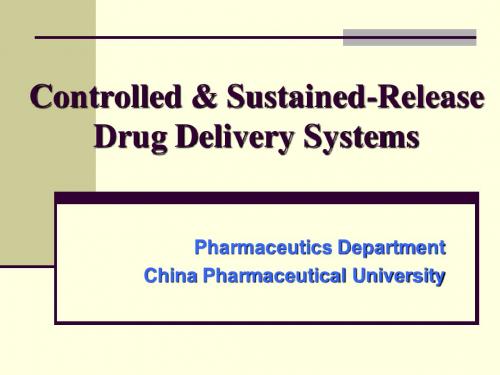
Chirico S., Dalmoro A., Lamberti G., et al. Analysis and modeling of swelling and erosion behavior for pure HPMC tablet. J Control Release, 2007,122(2): 181-188.
multichamber osmotic pump
Two-chamber OP with expanding compartment
Two-compartment OP with two drug chambers
5、ion exchange Controlled
树脂+--药物- + X- →树脂+--X- + 药物-
研 制 3)China : 1950s 上 市: 1970s 规模生产: 规模生产: 1980s 80年代初开始 80年代初开始 口服200余种 不同规格余的商品计有400种 余种, 目 前: 口服200余种,不同规格余的商品计有400种 已有近百种制剂获国家新药证书
国内部分上市品种
Nimodipine、Nifedipine、Nitrendipine、 、 、 、 Felodipine; Diclofenac、Naproxen、Tramadol、 、 、 、 Morphine; Nitroglycerol、Clonidine、Isosorbide 、 、 Mononitrate; Ticlopidine Hydrochloridc、Aspirin; 、 Acopolamine (patch)、Norgestrel (implants) 、
混合型 生物溶蚀系统
亲水凝胶骨架系统
膨胀控释骨架系统
Conti S. , Maggi L., Segale L., et al., Matrices containing NaCMC and HPMC 2. Swelling and release mechanism study[J] .In J Pharm,2007,333, 143–151
第十七章缓控释制剂、靶向制剂一、名词解释1.sustained-release...
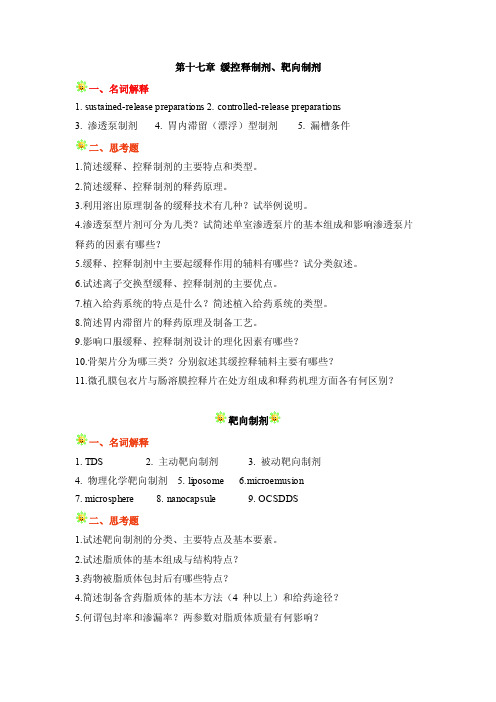
第十七章缓控释制剂、靶向制剂一、名词解释1. sustained-release preparations2. controlled-release preparations3. 渗透泵制剂4. 胃内滞留(漂浮)型制剂5. 漏槽条件二、思考题1.简述缓释、控释制剂的主要特点和类型。
2.简述缓释、控释制剂的释药原理。
3.利用溶出原理制备的缓释技术有几种?试举例说明。
4.渗透泵型片剂可分为几类?试简述单室渗透泵片的基本组成和影响渗透泵片释药的因素有哪些?5.缓释、控释制剂中主要起缓释作用的辅料有哪些?试分类叙述。
6.试述离子交换型缓释、控释制剂的主要优点。
7.植入给药系统的特点是什么?简述植入给药系统的类型。
8.简述胃内滞留片的释药原理及制备工艺。
9.影响口服缓释、控释制剂设计的理化因素有哪些?10.骨架片分为哪三类?分别叙述其缓控释辅料主要有哪些?11.微孔膜包衣片与肠溶膜控释片在处方组成和释药机理方面各有何区别?靶向制剂一、名词解释1. TDS2. 主动靶向制剂3. 被动靶向制剂4. 物理化学靶向制剂5. liposome6.microemusion7. microsphere 8. nanocapsule 9. OCSDDS二、思考题1.试述靶向制剂的分类、主要特点及基本要素。
2.试述脂质体的基本组成与结构特点?3.药物被脂质体包封后有哪些特点?4.简述制备含药脂质体的基本方法(4 种以上)和给药途径?5.何谓包封率和渗漏率?两参数对脂质体质量有何影响?6.乳剂的靶向性有何特点?乳化剂种类和用量对其靶向性有何影响?7.微球有何特性?试简述微球的制备方法。
8.纳米囊和纳米球有何特点和应用?9.主动靶向制剂是如何分类的?试叙述之。
10.何谓靶向前体药物?常见主要类型有哪些?11.物理化学靶向制剂常见主要类型有哪些?试简述之。
参考答案:一、名词解释1. sustained-release preparations缓释制剂系指用药后能在较长时间内持续释放药物以达到长效作用的制剂。
缓控释制剂

水不溶性骨架缓、控释制剂中药物的释放符合 Higuchi方程: Q=[DS(p (2A-Sp)t]1/2
式中, Q -单位面积在 t 时间的释放量, D -扩散系数, p-骨架中的孔隙率,S-药物在释放介质中的溶解度, -骨架中的弯曲因素,A-单位体积骨架中药物含量。
22
半透膜包衣材料 渗透压活性物质 促渗透聚合物又称推 进剂、膨胀剂 (HPMC等) 致孔剂 其他
水
水
30
(五)离子交换作用
药物游离释放: 树脂+-药物-+X-=树脂+-X-+药物+
树脂--药物++Y+=树脂--Y++药物X-和Y+为消化道中的离子,交换后游离的药物 从树脂中扩散出来。
一、缓、控释剂型的释药类型
(一) 骨架型缓、控释制剂 1、骨架片 (1)亲水性凝胶骨架片
骨架材料:HPMC-K4M (4000 cPa∙s)、HPMC-K15M (15000 cPa∙s)、MC (400 cPa∙s,4000 cPa∙s)、羟乙基 纤维素(HEC)、CMC-Na、海藻酸钠等。
41
主要辅料: HPMC 丙烯酸树脂 乙基纤维素 蜡类 脂肪酸类
18
(二)扩散原理
1、透膜扩散——膜材料控制型(水不溶性 包衣膜) 2、膜孔扩散——多孔膜控制型(含水性通 道) 3、骨架材料扩散——孔道控制
19
药物的释放以扩散为主的结构有以下几种:
1、水不溶性膜材包衣 如 EC 包制的微囊和小丸,其释放速度符合 Fick 第 一定律: dM/dt=ADKΔC/L
释放过程可接近零级过程 ( 若A、 D、 K 、 ΔC、 L 恒定 ) 或是 非零级过程(若A、D、K、ΔC、L中有一个或多个变化) 。
初级药师相关专业知识药剂学(新剂型)-试卷1
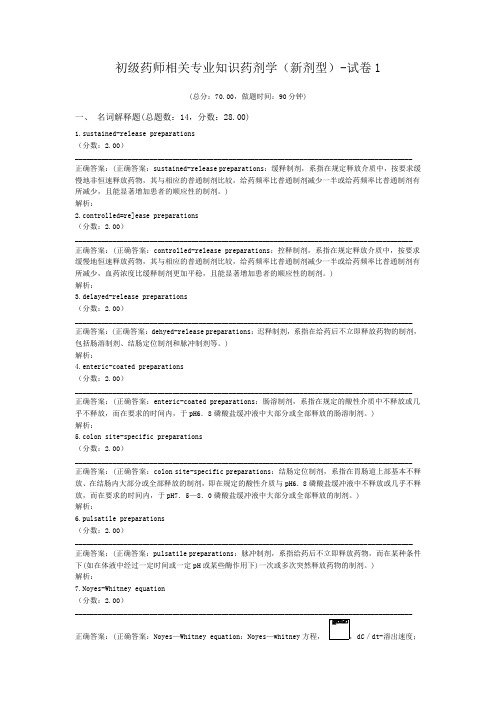
初级药师相关专业知识药剂学(新剂型)-试卷1(总分:70.00,做题时间:90分钟)一、名词解释题(总题数:14,分数:28.00)1.sustained-release preparations(分数:2.00)__________________________________________________________________________________________ 正确答案:(正确答案:sustained-release preparations:缓释制剂,系指在规定释放介质中,按要求缓慢地非恒速释放药物,其与相应的普通制剂比较,给药频率比普通制剂减少一半或给药频率比普通制剂有所减少,且能显著增加患者的顺应性的制剂。
)解析:2.controlled=re]ease preparations(分数:2.00)__________________________________________________________________________________________ 正确答案:(正确答案:controlled-release preparations:控释制剂,系指在规定释放介质中,按要求缓慢地恒速释放药物,其与相应的普通制剂比较,给药频率比普通制剂减少一半或给药频率比普通制剂有所减少,血药浓度比缓释制剂更加平稳,且能显著增加患者的顺应性的制剂。
)解析:3.delayed-release preparations(分数:2.00)__________________________________________________________________________________________ 正确答案:(正确答案:dehyed-release preparations:迟释制剂,系指在给药后不立即释放药物的制剂,包括肠溶制剂、结肠定位制剂和脉冲制剂等。
药剂学-缓释控释制剂

注释:药物包埋在疏水性骨架材料中,降低药物 的润湿性,减缓水向丸内渗透和药物的溶解。
2021/4/29
二 、膜控型缓释、控释制
材料。
2021/4/29
缓、控释制剂的制备
43
一 骨架型缓释、控释制剂
5 骨架型小丸 与骨架片的类型类似
小丸成型技术
滚动成丸法 挤压-滚圆法 离心-流化造丸法
小丸不受胃排空影响,吸收重现性好
2021/4/29
缓、控释制剂的制备
44
挤出滚圆法制备茶碱骨架小丸
处方:主药与骨架材料之比为1:1,骨架材料为单 硬脂酸甘油酯和微晶纤维素(1:4)
接压片
2021/4/29
缓、控释制剂的制备
42
一 骨架型缓释、控释制剂
2 缓释、控释颗粒(微囊)压制片
用不同溶解性能的粘合剂制粒,药颗粒在肠液中溶解所控 制。 释药速率:明胶>醋酸乙烯>虫胶
制成微囊后压片,片剂崩解后,药物的释放与微囊有关。 药物先包成控缓释小丸压片,药物的释放取决于小丸包衣
有缓释效果,溶出为药物释放和吸收的限 速步骤。 (4) 分配系数; 油水分配系数适中吸收好 (5)胃肠道稳定性。
2021/4/29
2、生物因素
(1) 生物半衰期
➢t1/2>24h,不采用缓释剂型; ➢t1/2<1h,不宜制成缓释剂型,因为维持治 疗浓度,必须加大单位给药剂量;
➢ 大多数药物在小肠吸收,药物释放不宜 设计成12小时以上;
➢如果结肠有吸收,可以设计成24小时缓 释。
药剂学名词解释
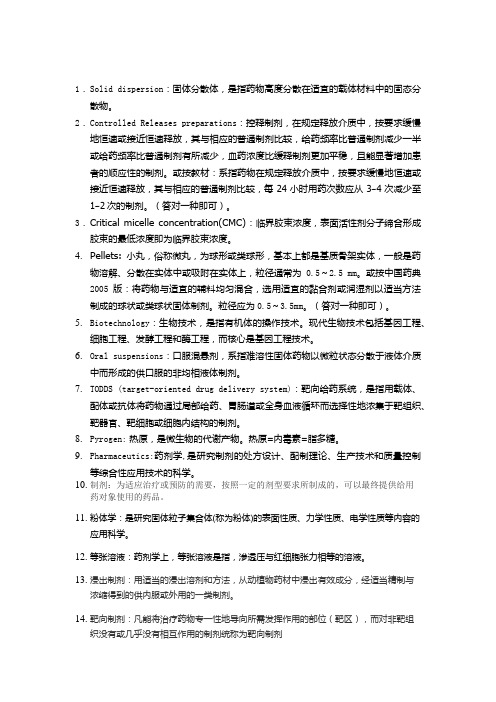
1.Solid dispersion:固体分散体,是指药物高度分散在适宜的载体材料中的固态分散物。
2.Controlled Releases preparations:控释制剂,在规定释放介质中,按要求缓慢地恒速或接近恒速释放,其与相应的普通制剂比较,给药频率比普通制剂减少一半或给药频率比普通制剂有所减少,血药浓度比缓释制剂更加平稳,且能显著增加患者的顺应性的制剂。
或按教材:系指药物在规定释放介质中,按要求缓慢地恒速或接近恒速释放,其与相应的普通制剂比较,每24小时用药次数应从3~4次减少至1~2次的制剂。
(答对一种即可)。
3.Critical micelle concentration(CMC):临界胶束浓度,表面活性剂分子缔合形成胶束的最低浓度即为临界胶束浓度。
4.Pellets: 小丸,俗称微丸,为球形或类球形,基本上都是基质骨架实体,一般是药物溶解、分散在实体中或吸附在实体上,粒径通常为0.5~2.5 mm。
或按中国药典2005版:将药物与适宜的辅料均匀混合,选用适宜的黏合剂或润湿剂以适当方法制成的球状或类球状固体制剂。
粒径应为0.5~3.5mm。
(答对一种即可)。
5.Biotechnology:生物技术,是指有机体的操作技术。
现代生物技术包括基因工程、细胞工程、发酵工程和酶工程,而核心是基因工程技术。
6.Oral suspensions:口服混悬剂,系指难溶性固体药物以微粒状态分散于液体介质中而形成的供口服的非均相液体制剂。
7.TODDS (target-oriented drug delivery system):靶向给药系统,是指用载体、配体或抗体将药物通过局部给药、胃肠道或全身血液循环而选择性地浓集于靶组织、靶器官、靶细胞或细胞内结构的制剂。
8.Pyrogen:热原,是微生物的代谢产物。
热原=内毒素=脂多糖。
9.Pharmaceutics:药剂学,是研究制剂的处方设计、配制理论、生产技术和质量控制等综合性应用技术的科学。
药剂学课件17第十七章:缓、控释制剂
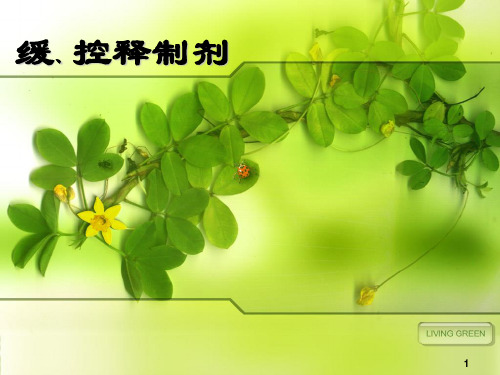
(二)扩散原理
以扩散为主的缓、控释制剂,药物 首先溶解成溶液后再从制剂中扩散出来 进入体液,其释药受扩散速率控制。
18
药物的释放以扩散为主的结构:
1、水不溶性包衣膜
如EC包制的微囊和小丸,其释放速度符合Fick
第一定律:dM/dt=ADKΔC/L
式中, dM/dt -释放速度, A-面积,D-药物扩散系数, K-药物在膜和囊芯之间的分配系数, ΔC-膜内外浓度差,L- 包衣层厚度。
25
(四)渗透压原理
1、渗透泵型片剂结构:
①片芯:水溶性药物和水溶性聚合物或其他辅料 制成;
②半透膜:用水不溶性的聚合物(如醋酸纤维素 (CA)、EC或EVA等)水可渗进此膜,但药物不能;
③释药孔:壳顶用适当方法(如激光)开一个或多 个细孔。
26
(四)渗透压原理
2、释药原理: 3、优点:药物以零级速率释放,释放速
13
三、不宜制成缓、控释制剂的药物:
6.溶解度极差的药物; 7.首过作用较强的药物; 8.药效剧烈或药物剂量需精密调节
的药物; 9.抗生素类药物。·
14
第二节 缓(控)释制剂的释药原理与处方设计
一、释药原理和方法
缓(控)释制剂主要有骨架型和贮库型两 种。
释药原理主要有溶出、扩散、溶蚀、渗 透压及离子交换。
波谷的现象,有利于降低药物毒副作用; 4.减少用药的总剂量; 5.降低研发的费用,减少医疗总费用;
8
硝苯地平不同制剂比较表
给药次 血药浓度 数(日) 普通片 4~6次 波动大
缓释片 2次 较平稳
用药总量 副 作 用
40~60mg 面红、心悸、 头晕等较重
20mg
轻
控释片 1次
中国药科大学__工业药剂学__试卷(3套)
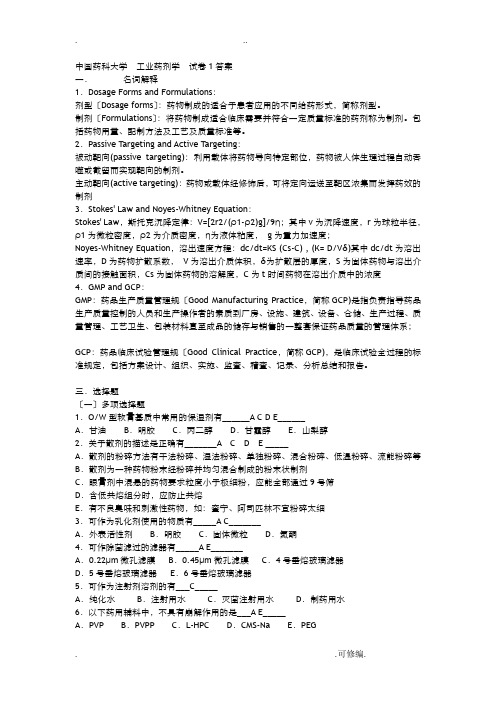
中国药科大学工业药剂学试卷1答案一.名词解释1.Dosage Forms and Formulations:剂型〔Dosage forms〕:药物制成的适合于患者应用的不同给药形式,简称剂型。
制剂〔Formulations〕:将药物制成适合临床需要并符合一定质量标准的药剂称为制剂。
包括药物用量、配制方法及工艺及质量标准等。
2.Passive T argeting and Active T argeting:被动靶向(passive targeting):利用载体将药物导向特定部位,药物被人体生理过程自动吞噬或截留而实现靶向的制剂。
主动靶向(active targeting):药物或载体经修饰后,可将定向运送至靶区浓集而发挥药效的制剂3.Stokes' Law and Noyes-Whitney Equation:Stokes' Law,斯托克沉降定律:V=[2r2/(ρ1-ρ2)g]/9η;其中v为沉降速度,r为球粒半径,ρ1为微粒密度,ρ2为介质密度,η为液体粘度,g为重力加速度;Noyes-Whitney Equation,溶出速度方程:dc/dt=KS (Cs-C) , (K= D/Vδ)其中dc/dt为溶出速率,D为药物扩散系数,V为溶出介质体积,δ为扩散层的厚度,S为固体药物与溶出介质间的接触面积,Cs为固体药物的溶解度,C为t时间药物在溶出介质中的浓度4.GMP and GCP:GMP:药品生产质量管理规〔Good Manufacturing Practice,简称GCP)是指负责指导药品生产质量控制的人员和生产操作者的素质到厂房、设施、建筑、设备、仓储、生产过程、质量管理、工艺卫生、包装材料直至成品的储存与销售的一整套保证药品质量的管理体系;GCP:药品临床试验管理规〔Good Clinical Practice,简称GCP),是临床试验全过程的标准规定,包括方案设计、组织、实施、监查、稽查、记录、分析总结和报告。
中国药科大学《工业药剂学》各章节练习题

中国药科大学《工业药剂学》练习题第一章总论一、名词解释1. 药剂学2. 药典3. 处方4. GMP5. GLP6. DDS7. OTC 8. USP 9. 制剂10. 剂型 11. 溶液型分散系统 12. 乳剂型分散系统13. 混悬型分散系统 14. 非胃肠道给药制剂 15. 固体型分散系统16. 气体型分散系统二、思考题1. 药剂学的分支学科有哪些?试分别解释各学科的定义。
2. 药剂学研究的主要任务是什么?3. 药剂学总体发展可划分为哪三个时期?4. 现代药剂学的核心内容是什么?5. 目前颁布的中国药典和国外药典有哪些?最新版本是哪一版?6. 简述药剂学的进展。
7. 药物剂型可分为几类?试分别叙述。
8. 剂型的重要性主要包括哪些?9. 药物制剂和剂型的发展可分为哪四个时代?试分别叙述。
10. 药物制剂的基本要素是什么?11. 试述药物制剂与多学科的关系。
12. 试述片剂在制备与贮存期间的注意事项。
第二章液体制剂一、名词解释1.液体药剂2.流变性3.溶解、溶解度和溶解速度4.潜溶和助溶5.增溶和胶束6.HLB值、CMC、cloud point7.乳剂和混悬剂8.凝胶和胶凝9.絮凝和反絮凝10.微乳和复乳 11.Zeta 电位 12. 娇味剂13. 芳香剂 14. 着色剂 15. 掩蔽剂二、思考题1. 1.液体制剂的特点及其分类方法有哪些?简述均相和非均相液体制剂的特征。
2. 2.试述分散度与疗效、稳定性之间的关系。
3. 3.牛顿流体的特点是什么?非牛顿流动流动曲线有哪几种类型?4. 4.流变学在药剂学中的有何应用?5. 5.增加药物溶解度的方法有哪几种?6. 6.根据 Noyes-Whitney 方程,简述影响溶解速度的因素。
7.7.试述表面活性剂定义、分类及结构特点。
8.8.影响表面活性剂增溶的因素有哪些?9.9.试举例简述各类表面活性剂的特点和在药剂学中的应用。
10.10.简述表面活性剂的生物学性质。
缓控释制剂PPT课件

18
Matrix Controlled-Release
主要辅料: HPMC 丙烯酸树脂 乙基纤维素 蜡类 脂肪酸类
19
(二)扩散原理
1、透膜扩散——膜材料控制型(水不溶性 包衣膜)
2、膜孔扩散——多孔膜控制型(含水性通 道)
4
控释制剂(controlled release preparation):指在 规定释放介质中,按要求缓慢地恒速或接近恒速 释放药物,与相应的普通制剂比较,给药频率比 普通制剂减少一半或给药频率比普通制剂有所减 少,血药浓度比缓释制剂更加平稳,且能增加患 者的顺应性的制剂。又称口服定速给药系统。
TI 小 、 药 效 时 间 长
临床使用 药量大,多次频繁给药、药量小、给药次数少、使用
使用不便、安全性低 方便、安全性高
适用范围
多用于短暂治疗 普通应用于长期预防及治疗
研究制造简单、粗糙Fra bibliotek复杂、精密
12
13
四、缓释控释制剂的分类
1、骨架型缓、控释制剂:包括亲水凝胶骨架片、蜡质骨 架片、不溶性骨架片和骨架型小丸等。
3、骨架材料扩散——孔道控制
20
药物的释放以扩散为主的结构有以下几种: 1、水不溶性膜材包衣 如EC包制的微囊和小丸,其释放速度符合Fick第
一定律: dM/dt=ADKΔC/L
释放过程可接近零级过程(若A、D、K、ΔC、L恒定)或是 非零级过程(若A、D、K、ΔC、L中有一个或多个变化) 。
缓控释制剂
中国药科大学 吴琼珠
1
概述
1
点击输入简要文字内容,文字内容需概括精炼,不用多余 的文字修饰,言简意赅的说明分项内容……
中国药科大学 药剂学 试卷答案

中国药科大学工业药剂学试卷3答案一.名词解释1.1.剂型与制剂剂型:药物不能直接供患者用于疾病的防治,必须制成适合于患者应用的最佳给药形式,即药物剂型或称剂型制剂:根据药典和部颁标准,将药物制成适合临床需要并符合一定质量标准的药剂称为制剂2.2.GLP 与 GCPGLP:药品安全试验规范Good Laboratory Practice,简称GLP,是在新药研制的实验中,进行动物药理试验包括体内和体外试验的准则,如急性、亚急性、慢性毒性试验、生殖试验、致癌、致畸、致突变以及其它毒性试验等都有十分具体的规定,是保证药品研制过程安全准确有效的法规;GCP:药品临床试验管理规范Good Clinical Practice,简称GCP,是临床试验全过程的标准规定,包括方案设计、组织、实施、监查、稽查、记录、分析总结和报告; 3.3.Isoosmotic Solution 与 Isotonic solutionIsoosmotic Solution:等渗溶液是指渗透压与血浆相等的溶液,是物理化学的概念Isotonic solution:等张溶液是指与红细胞张力相等,也就是与细胞接触时使细胞功能和结构保持正常的溶液,是生物学的概念4.4.F与F值Fo值表示一定灭菌温度T,Z值为10℃时,一定灭菌温度T产生的灭菌效果与121℃,Z 值为10℃产生的灭菌效力相同时所相当的时间min;即将被灭菌物品各不同受热温度均所达到与湿热灭菌121℃产生的灭菌效力相同时所相当的灭菌时间F值为在一定温度T,给Z值所产生的灭菌效力与参比温度To给定Z值所产生的灭菌效果相同时所相当的时间5.5.微球与微囊微球microsphere:药物以溶解或分散的状态存在于高分子材料中,以适宜的技术制备而成的骨架型微小球体,称为微球微囊microcapsules:利用天然或合成的高分子材料包裹固体或液体药物而形成的药库型微笑囊体,称为微囊二.选择题1.可作为粉针剂溶剂的有 CA 纯化水B 注射用水C 灭菌注射用水D 制药用水2.片剂辅料中的崩解剂是 BA ECB PVPPC 微粉硅胶D MCE 甘露醇3.可作除菌滤过的滤器有 A EA μm微孔滤膜B μm微孔滤膜C 4号垂熔玻璃滤器D 5号垂熔玻璃滤器E 6号垂熔玻璃滤器W型软膏基质中常用的保湿剂有 A C D EA 甘油B 明胶C 丙二醇D 甘露醇E 山梨醇5.空心胶囊的型号有 D 种,最小型号是 A 号;A 5B 6C 7D 8E 9F 06.单凝聚法制备以明胶为囊材的微囊时,固化微囊可以加入 C DA 乙醇B 氢氧化钠C 甲醛D 戊二醛E 丙二醇7.具有较多水份的油脂性软膏基质的是 CA 固体石蜡B 液体石蜡C 凡士林+羊毛脂D 凡士林 E.硅酮8.下列哪一条不符合散剂制备方法的一般规律 BA 组分比例差异大者,采用等量递加混合法B 组分堆密度差异大时,堆密度大者先放入混合容器中,再放入堆密度小者C 含低共熔组分时,应避免共熔D 剂量小的毒剧药,应制成倍散E 含液体组分,可用处方中其他组分或吸收剂吸收9.反映难溶性固体药物吸收的体外指标主要是 AA 溶出度B 崩解时限C 片重差异D 含量E 脆碎度10.药筛筛孔目数习惯上是指 CA 每厘米长度上筛孔数目B 每平方厘米面积上筛孔数目C 每英寸长度上筛孔数目D 每平方英寸面积上筛孔数目E 每市寸长度上筛孔数目11.关于表面活性剂的叙述中哪一条是正确的 C EA 能使溶液表面张力增加的物质B 能使溶液表面张力不改变的物质C 能使溶液表面张力急剧下降的物质D 能使溶液表面张力急剧上升的物质E 表面活性剂都具有亲水和亲油基团12.下列高分子材料中,不是肠溶衣的是 EA.虫胶 C. Eudragit S D. CAP E. CMCNa13.在片剂的薄膜包衣液中加入液体石蜡的作用为 AA.增塑剂B.致孔剂C. 助悬剂D. 乳化剂E. 成膜剂14.泡腾颗粒剂遇水产生大量气泡,这是由于颗粒剂中酸与碱发生反应后所放出的何种气体所致 BA. 二氧化硫B. 二氧化碳C. 氧气D. 氢气E. 氮气15.易发生水解的药物为 DA. 酚类药物B. 烯醇类药物C.多糖类药物D.酰胺与酯类药物E.蒽胺类药物16.已知某药物水溶液在常温下的降解速度常数为×10-6/h,则其有效期为___C____年;A 4B 2CD 1 E17.噻孢霉素钠的氯化钠等渗当量为,欲配制3%的注射剂500ml,需加氯化钠___C_克;A B 1.42 C D E18.药物制成以下剂型后那种显效最快____D____A 口服片剂B 硬胶囊剂C 软胶囊剂D 颗粒剂19.液体粘度随切应力增加不变的流动称为___D__A 塑性流动B 胀性流动C 触变流动D 牛顿流动E 假塑性流动20.下列关于尼泊金酯类的说法正确的是___B C___A 在碱性溶液中比在酸性溶液中抑菌能力更强 B在酸性溶液中比在碱性溶液中抑菌能力更强 C 尼泊金甲酯比丁酯抑菌能力更强 D 尼泊金甲酯比丁酯抑菌能力弱 E 本类防腐剂遇铁不变色三.填空1.1.为防止某药物氧化,可采取的措施有包衣避光、加入抗氧剂、通惰性气体、络合金属离子等;2.2.PEG在药剂学中有广泛的应用,如作为注射剂溶媒、包衣材料、固体分散体基质、保湿剂、软膏基质等;3.3.常用的软膏剂基质有水溶性基质__、油溶性基质_、和 _乳膏型基质__; 4.4.热原是微生物产生的一种内毒素,其主要成分是脂多糖,去除的方法有高温法、酸碱法、吸附法、离子交换法等;5.5.经皮吸收制剂大致可分为 _膜控释型___、粘胶分散型、_骨架扩散型_、和微贮库型等;6.6.从方法学上分类,靶向制剂大体上可分为_物理化学靶向_、__被动靶向_、主动靶向__;7.7.固体分散体的速效原理包括_药物高度分散_、载体材料提高药物润湿性、载体材料对药物的抑晶作用和载体材料保证药物的高度分散等;8.8.为增加混悬剂的物理稳定性,可加入稳定剂,稳定剂包括絮凝剂、反絮凝剂、助悬剂和润湿剂等;9.9.目前中国药典溶出度检查的方法有小杯法、转篮法和桨法 ; 10.10.表面活性剂在药剂学中的应用有乳化、起泡和消泡、消毒和杀菌、增溶、去污等;四.处方分析并简述制备过程1Rx片芯处方:1000片用量处方分析阿司匹林 25g主药淀粉 32g填充剂L-HPC 4g崩解剂10%淀粉浆粘合剂滑石粉润滑剂制备过程:素片制备:将阿司匹林过80目筛,与淀粉混匀,加淀粉浆制成软材,用14目筛制粒,置70干燥后于12目筛整粒,加入滑石粉混匀后,压片,得素片;片剂包衣:按处方量配制好包衣液后,设置仪器参数,将包衣液参数喷入放置了素片的包衣锅中,待一定时间后将包好异的片剂取出即得;2Rx士林及液状石蜡加热熔化为油相;另将甘油、三乙醇胺及蒸馏水加热至90℃,再加入十二烷基硫酸钠溶解为水相;然后将水相缓缓倒入油相中,边加边搅,直至冷凝,即得乳剂型基质,将过筛的水杨酸加入上述基质中,搅拌均匀即得;五.问答题1.1.什么是缓释、控释制剂,试述其主要特点、释药原理及常用剂型;2.2.大部分片剂制备采用制粒压片工艺,请问制粒方法有哪些各有何特点制粒过程又有何意义3.3.热原的组成、性质及除去方法说明注射剂的质量要求及其检查方法第一题:1定义:缓释制剂:sustained –release preparations,指口服药物在规定的溶剂中,按要求缓慢的非恒速释放,且每日用药次数与相应普通制剂比较至少减小一次或用药间隔有所延长的制剂; 控释制剂:controlled-release preparations, extended- release preparations,指口服药物在规定的溶剂中,按要求缓慢的恒速或接近恒速释放,且每日用药次数与相应普通制剂比较至少减小一次或用药间隔有所延长的制剂; 2特点:对半衰期短或需要频繁给药的药物,可以减少服药次数,使用方便,提高病人服药的顺应性,特别适于需长期服药的慢性病患者,如心血管疾病、心绞痛、高血压、哮喘;使血药浓度平稳,避免峰谷现象,易于降低药物的副作用,特别有利于治疗指数狭窄的药物;可减少用药的总剂量,使得药物以最小剂量达到最大药效;3释药原理:溶出原理:将药物制成溶解度小的盐和酯、与高分子化合物生成难溶性盐、控制粒子大小、将药物包藏于溶蚀性或亲水性胶体骨架中等方法来控制药物的溶出速度;扩散原理:利用增加粘度、包衣、制成微囊、植入剂、不溶性骨架片以及乳剂等工艺手段,控制药物从制剂释放速度;溶蚀与扩散、溶出结合:采用溶蚀型、膨胀型、聚合物等骨架材料制备的缓控释制剂;渗透压原理:利用渗透压的差别,使得药物饱和溶液由细孔溶出,能均匀恒速地释放药物离子交换作用:将药物可结合于水不溶性交联聚合物组成的树脂上;当带有适当电荷的离子与离子交换基团发生接触时,通过交换将药物有利释放出来4常用剂型:骨架型:包括亲水凝胶骨架片、蜡质骨架片、不溶性骨架片和骨架型小丸膜控型:包括微孔膜包衣片、肠溶膜控释片、膜控释小片、肠控释小丸渗透泵控释制剂植入型透皮给药系统脉冲式释药系统或自调式释药系统第二题:制粒方法与特点:制粒系指将将药物与辅料混合物加工制成一定形状和大小的粒子,可分为干法制粒和湿法制粒;湿法制粒:药物混合物中加入黏合剂,借助黏合剂的架桥和粘结作用使得粉末聚集一起而制成颗粒的方法;包括挤压制粒、转动制粒、搅拌制粒等,具有粒子大小可调、压缩性、成型性好、适用范围广等特点;干法制粒:把药物混合物粉末直接压缩成较大片剂或片状物后,重新粉碎成所需大小颗粒的方法,有压片法和滚压法;该方法不加任何液体,常用于热敏性物料、遇水易分解的药物以及容易压缩成形的药物的制粒,方法简单、省工省时;但采用干法制粒时,应注意由于压缩引起的晶型转变及活性降低等;制粒具有以下意义:增加制剂的可压性增加辅料的流动性可以防止各成分筛分可以防止粉尘飞扬可以防止药粉聚集第三题:组成:热原是微生物的一种内毒素,内毒素由磷脂、脂多糖和蛋白质组成,其中脂多糖是内毒素的主要组成成分,故可认为内毒素=热原=脂多糖;性质:热原具有耐热性、滤过性、水溶性、不挥发性及能被强酸强碱等破坏;除去方法:高温法、酸碱法、吸附法、离子交换法、凝胶滤过法、反渗透法;质量要求;无菌、无热原、澄明度、安全性、渗透压、pH值、稳定性和降压物质;。
11缓释与控释制剂

§ 腔道和粘膜用控释制剂 缓释控 释制剂
Dr. JIA NG Shuguang
缓释控 释制剂
Dr. JIA NG Shuguang
§ 眼用控释膜 分非溶蚀性和溶蚀性眼用膜剂两种。 § 口 腔粘膜 贴片 用 卡波姆 、HPMC、MC、CMC-Na、海藻酸钠 等材 料制得。 § 鼻 腔粘膜 控释制剂 药物与 辅 料 制 成亲水 性 凝 胶 或 微球 系 统,药物在鼻腔粘膜的滞留时间延长。 § 宫颈 粘 贴片 药物与药用 高分子 制成片 剂。 吸收水 份后可牢 固地粘着于宫颈,缓慢地释放药物。 8
增厚延缓药物释放;骨架同时溶蚀。 @ 水溶性药物以扩散为主;难溶性药物则以骨架溶蚀为主。
14
第三节
缓释与控释制剂的 释药原理和方法
第三节
缓释与控释制剂的 释药原理和方法
Ø 释药原理(con’t)
§ 渗透压原理 F 利 用 渗 透 压原理可制成 口服 渗透 泵 片 和渗 透植入 剂, 它们均能在体内均匀恒速地释放药物。 @ 单室泵型口服渗透泵片结构
F 离 于 交换 树脂 是 由线型 离 子 型聚合 物 经交联而成 ,树
液,具高渗透压辅料溶解,膜内的溶液为高渗溶液。
F 由 于膜 内外存在渗透压差,药液通过释药小孔持续泵出,其流出
量与渗透进入膜内的水量相等。
缓释控 释制剂
Dr. JIA NG Shuguang
F 控制水 的渗入速率即可控制药物的释放速率,而水的渗入速率取
dC = S ⋅ k ⋅ (C s − C t ) dt
@S——固体的 表面积↓ @k——溶出速率 常数 @Cs——介质中药物的溶解度 ↓ @Ct——药物在 介质中的 浓度。
缓释控 释制剂
Dr. JIA NG Shuguang
药剂学第十九章缓释、控释制剂和迟释制剂

第十九章缓释、控释制剂和迟释制剂一、概念与名词解释1.controlled—release preparations2.生物利用度3.生物等效性4.sustained release formulations5.靶向制剂6.主动靶向制剂7.EPR效应二、判断题(正确的划√,错误的打×)1.药物制剂的发展可将制剂分为5代。
()2.缓控释制剂以静脉注射剂作标准参比制剂,两者血中药物浓度不呈现明显差别时,即认为生物等效.()3.抗菌素类药物宜于制成缓控释制剂。
( )4.剂量大于l克的药物不宜制成缓控释制剂。
( )5.半衰期小于1小时或大于12小时的药物,一般不宜制成缓、控释制剂。
()6.半衰期很长的药物不宜制成缓、控释制剂。
()7.缓、控释制剂在获得预期疗效的同时,可以减小药物的毒副作用.( )8.缓、控释制剂主要有骨架型和贮库型两种类型.()9.减小药物的粒径,降低药物的溶出速度,可使药物缓慢释放,达到长效.( )10.缓释制剂可以通过适当的制备手段使得所有药物都可以缓释.()11.邻苯二甲酸酞酸酯(CAP)、Eudragit E、L和S都为肠溶性材料.( )12.缓、控释制剂的生物利用度应为普通制剂的譬80%一120%。
()13.渗透泵片中药物的释放速率为零级,并与pH无关。
()14.某些药物需包肠溶衣,这是为了防止其在胃内分解或对胃有刺激。
( )15.制成塑料骨架片形式长效制剂,药物必须是易溶于水。
( )16.在胃肠分解的药物应包肠溶衣。
()17.缓控释制剂与普通制剂相比可减少用药的总剂量,因此可用最小剂量达到最大药效。
( )18.药物以分子或微晶、微粒的形式均匀分散在各种载体材料中,形成贮库型缓、控释制剂。
()19.青霉素普鲁卡因盐的溶解度比青霉素钾盐的溶解度小,因此有可能延长药效.( ) 20.药物在胃、小肠和结肠都有吸收时,可以考虑设计24小时服用一次的缓释制剂.()21.华法林不适于制成缓释制剂是由于其半衰期很长。
- 1、下载文档前请自行甄别文档内容的完整性,平台不提供额外的编辑、内容补充、找答案等附加服务。
- 2、"仅部分预览"的文档,不可在线预览部分如存在完整性等问题,可反馈申请退款(可完整预览的文档不适用该条件!)。
- 3、如文档侵犯您的权益,请联系客服反馈,我们会尽快为您处理(人工客服工作时间:9:00-18:30)。
3)其它(Others):Osmotic pumps、Implanted 、 Impulsive preparations、 Transdermal therapeutic system(TTS)、Self-regulated DDS etc.
Fick‘s Diffusion Law : dM/dt=ADK△C/L
Higuchi Equation: Q=[DCs(P/λ)(2A-CsP)t]1/2
Diffusion controlled
释药受扩散速率控制
1、水不溶性包衣膜: 2、含水性孔道的包衣膜 3、骨架型药物扩散
Chirico S., Dalmoro A., Lamberti G., et al. Analysis and modeling of swelling and
膜控型微丸基本结构
基丸
聚合物缓释 包衣层
药物层 色衣层
骨架型片剂释药示意图
Chapter 2 Basic Concept
3、Characteristics
Theory of DDS
Characteristics
1)Safe:血浓平稳,避免峰谷现象,降低毒副作用; 2)Effect:降低胃肠道刺激,提高生物利用度,减少给
Controlled release 种类、品种较少 处方工艺较复杂 质量标准要求高
Chapter 2 Basic Concept
2、Classification
Types of Drug Delivery Systems
1)骨架型( Matrix):Hydro gels、Wax、Insoluble matrixes etc. 释药过程flash
国内部分上市品种
Nimodipine、Nifedipine、Nitrendipine、 Felodipine;
Diclofenac、Naproxen、Tramadol、Morphine; Nitroglycerol、Clonidine、Isosorbide
Mononitrate; Ticlopidine Hydrochloridc、Aspirin; Acopolamine (patch)、Norgestrel (implants)
Chapter 4 Drug & Formula Design 1、Common Choice
1)药物一般选择原则: 1)给药剂量 2)水溶性、pKa、分配系数 3)稳定性
2)药物的剂量设计: 一般情况: 缓控释制剂总剂量=普通剂量×缓释间隔/普通间隔
3)剂型选择: 根据临床评价,血浓波动、个体差异、治疗效果等: 1)骨架型>包衣型(渗透泵除外); 2)高聚物骨架>脂肪骨架; 3)贴剂时滞长,植入“突释”严重。 4)处方和工艺设计 药物特性→剂型→处方→制备工艺→质量控制
3、Corrosion/Diffusion/ Dissolution Combine Controlled
混合型 生物溶蚀系统
亲水凝胶骨架系统
膨胀控释骨架系统
Conti S. , Maggi L., Segale L., et al., Matrices containinrelease mechanism study[J] .In J Pharm,2007,333, 143–151
Controlled & Sustained-Release Drug Delivery Systems
Pharmaceutics Department China Pharmaceutical University
Learning Objectives
To master the principle of drug release from DDS
Chapter 2 Basic Concept
1、Definition
Sustained-release preparation
缓释制剂——较长时间内持续释药 sustained-release ~, extended-release ~,
prolonged action ~, repeat-action ~, retarded preparations
Controlled-release preparation
控释制剂——以恒定速度药(狭义)。 广义:速度、时间、方向(部位)
Controlled Release vs. Sustained Release
Sustained release 种类、品种多(约 80%) 处方工艺简单 易于工业化大生产
6 12h (24h) 50% >70%
2)In vivo bioavailability
参比制剂:同类公认高质量制剂 试验方案:随机交叉(双盲)、单剂量和多剂量
3)in vitro-in vivo correlations
1、 Dissolution Controlled
Noyes-Whitney Equation
• Developed by Noyes Whitney in 1897
•
• If c << cs (i.e.,sink conditions)
→Methods to get extending
According Noyes-Whitney Equation
multichamber osmotic pump
Two-chamber OP with expanding compartment
Two-compartment OP with two drug chambers
5、ion exchange Controlled
树脂+--药物- + X- →树脂+--X- + 药物 树脂---药物++ Y+→树脂---Y+ +药物+
3)Physiologic Factor
A、Gastric emptying 对被动吸收药物:胃蠕动↑→胃排空↑→吸收↑(一般); 对主动吸收药物:胃蠕动↑→胃排空↑→吸收↓ B、Breakdown in the GIT C、Food influence
Michel MC ,Korstanje C ,Krauwinkel W, et al . The pharmacokinetic profile of tamsulosin oral controlled absorption system(OCAS) [J ] . Eur Urol Suppl ,2005 ,4 (2) :15 – 241
2、 Influencing Factors
1)Physico-chemical property of drugs A、Solubility(common>0.01mg/ml)
• 一般:溶解度愈小,溶出、吸收愈慢,起效愈慢,疗 效愈差(生物利用度愈低)。
• 若溶解度太小,应首先增加其溶出速度(微粉 化、固体分散体、包合物等)
basic concept, classification, advantage
Mechanism
5 types
Formula design
Common principle influencing factors formula design
examples
Chapter 1
History of DDS Development
erosion behavior for pure HPMC tablet. J Control Release, 2007,122(2): 181-188.
Methods with Diffusion controlled
coating microcapsule、microparticle等 Insoluble matrixes * Increasing viscosity implant emulsions
4、Osmotic Pressure Controlled
(1)渗透压动力释药 (2)恒速释药
促渗剂:乳糖、果糖、 葡萄糖、甘露糖等
推进剂:聚羟甲基丙 烯酸烷基酯、PVP等
Elementary osmotic pump
Verma RK,Krishna DM,Garg S. Formulation aspects in the development of osmotically controlled oral drug delivery systems[J ]J Control Release ,2002 ,79 (1 - 3) :7 - 27
1)Reducing the Cs 2) Reducing the dissolution rate
(1)Reducing the Cs
1)Salification
红霉素 红霉素乳糖酸盐(水溶性)
6h(0.2~0.5g/次) 8~12h(0.1~0.2g /次)
青霉素-普鲁卡因盐(5h→24h~48h)
药总剂量; 3)Convenience:延长给药间隔,减少服药频率,提高
服药依从性(Compliance)。
Quality control:成本较高,制造过程复杂,大生产易出 现质量问题(特别是膜控型)。
Chapter 3 Mechanism
5 Types of System Rate-controlled mechanism
N-甲基阿托品鞣酸盐(难溶性)等。
Reducing the Cs
2)Esterification
1)醇类药物的酯化,如:雌二醇的苯甲酸酯等。 2)核黄素月桂酸酯,60~90Day。
Reducing the Cs
